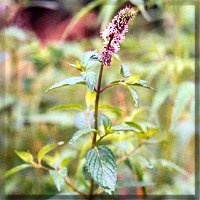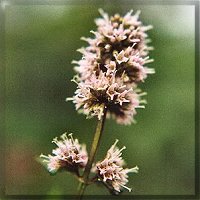


Mentha piperita



Mentha piperita
The Latin name mentha itself was borrowed from Greek minthe [μίνθη], whose origin is, however, unknown. It is already found in Mycenaean, the earliest recorded version of Greek, as mintha.
Description - Mint is really any number of plants belonging to the Labiatae family, all of which produce the characteristic minty scent when the leaves are crushed. There are three chief species of mint in cultivation and general use:
The most medicinal of the mints is Mentha piperita, peppermint, and when you are looking for mint to use for the stomach, make sure you specify peppermint.
Part used.—The leaves and flowering tops, for which there is a reasonably constant demand, collected as soon as the flowers begin to open and carefully dried. The production of peppermint oil by distillation of the cultivated herb is an extensive industry.* The wild form of the plant is not suitable for this purpose, the cultivated plant containing more and better oil.Pharmacology - The essential oil of peppermint (up to 2.5% in the dried leaves) is mostly made up from menthol (ca. 50%), menthone (10 to 30%), menthyl esters (up to 10%) and further monoterpene derivatives (pulegone, piperitone, menthofurane). Traces of jasmone (0.1%) improve the oil's quality remarkably. Menthol and menthyl acetate are responsible for the pungent and refreshing odour; they are mostly found in older leaves and are preferentially formed during long daily sunlight periods. On the other hand, the ketones menthone and pulegone (and menthofurane) have a less delightful fragrance; they appear to higher fraction in young leaves and their formation is preferred during short days.
Therapeutic Use - Peppermint facilitates digestion by stimulating the secretion of bile and digestive juices that break down the foods we eat. If these juices are not produced sufficiently, or if there has been an abnormally large intake of food, undigested food can begin to decay in the stomach, which doesn’t feel great. A cup of mint tea will stimulate the digestive system so that the food can be digested. When you have indigestion, the last thing you want to do is neutralize stomach acids - , your food can't be properly processed without them. Antacids and stomach tranquilizers merely mask the problem, and in fact, they often create new ones. When you take an antacid, it neutralizes stomach acids.
Medicinal Use - For flatulence, colic, languor, hysterical affections, retchings and other dyspeptic symptoms, acting as a cordial and often producing immediate relief, from its stomachic, antispasmodic and carminative qualities. It seems to act as soon as taken, and extend its effect through the whole system, instantly communicating a glowing warmth. Water extracts of the whole pungency of this herb by infusion.
Contra-indications - Caution is recommended in patients with hiatal hernia, kidney stones, or GI reflux.. Menthol products should not be used directly under the nose of small children and infants due to the risk of apnea. There are no data available of the safety of peppermint in pregnancy.